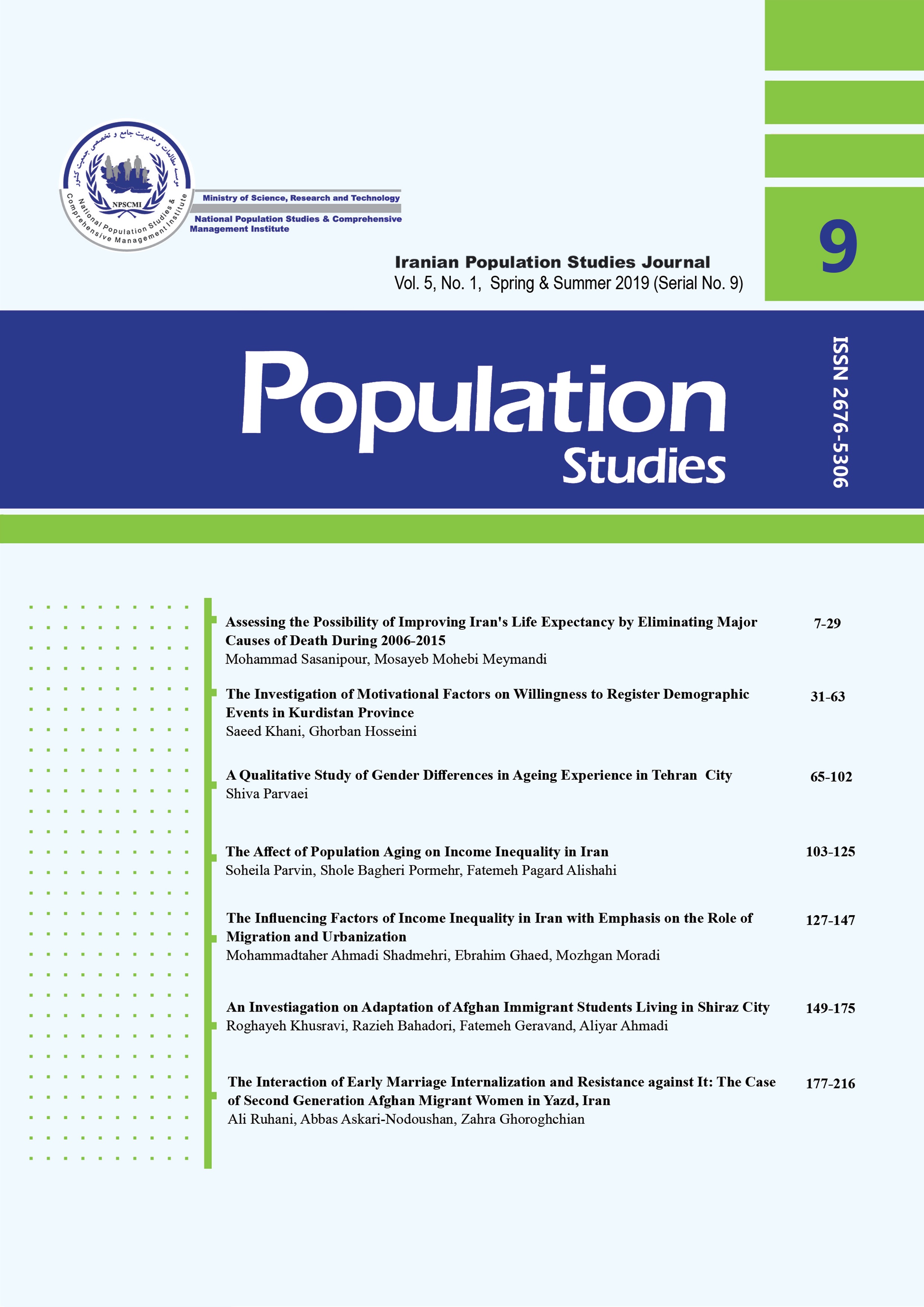ابریشمی، حمید، سجاد برخورداری و علیرضا قباشی (1398). تأثیر پویایی مهاجرت از روستا به شهر بر نابرابری توزیع درآمدی: مورد مطالعه مناطق روستایی ایران، فصلنامه مدلسازی اقتصادسنجی، دوره 3، شماره 3، صص 62-39.
باقرزاده، علی (1391). تحلیل عامل های موثربرکاهش نابرابری درآمدی در مناطق روستایی ایران (آزمون مدل خطی اهلووالیا)، اقتصاد توسعه و برنامه ریزی، دوره 1، شماره 2، 17-1.
دلانگیزان، سهراب، مریم پشته کشی و سهیلا نظری (1396). تأثیر نرخ شهرنشینی، آزادی اقتصادی و کیفیت حکمرانی بر نابرابری توزیع درآمد، اولین همایش بینالمللی برنامهریزی اقتصادی، توسعه پایدار و متوازن منطقهای رویکردها و کاربردها، دانشگاه کردستان.
دهقانی، علی، محمدحسن حسینی، محمد فتاحی و صمد حکمتی فرید (1396). بررسی رابطه بین رشد اقتصادی و توزیع درآمد در ایران طی دوره 1393-1350، رهیافت رگرسیون غیرخطی انتقال ملایم، فصلنامه علمی پژوهشی مطالعات اقتصاد کاربردی ایران، دوره 6، شماره 21، صص 213-236.
ربانی خوراسگانی، رسول، صمد کلانتری و نفیسه یاوری (1383). پدیده حاشیهنشینی و پیامدهای اجتماعی، فرهنگی آن (ارزنان و دارک اصفهان)، مجله پژوهشی علوم انسانی دانشگاه اصفهان، دوره 17، شماره 2، صص 154-119.
شاکری، عباس، اسفندیار جهانگرد و سمیه اقلامی (1392). اثر غیرخطی تورم بر نابرابری توزیع درآمد در ایران، فصلنامه پژوهشهای اقتصادی (رشد و توسعه پایدار)، دوره 13، شماره 4، صص 27-53.
مهرگان، نادر و صابر زمانی شبخانه (1392). بررسی اثر شهرنشینی بر توزیع درآمد در ایران با تأکید بر نظریه کوزنتس، فصلنامه علمی پژوهشی برنامهریزی و بودجه، دوره 1، شماره 3، صص 19-3.
مهرگان، نادر، عزتاله عباسیان و اردلان، بهرام (1393). تجزیه چندگانه نابرابری توزیع درآمد در ایران با رویکردی به ضریب جینی تعمیم یافته، فصلنامه سیاستگذاری پیشرفت اقتصادی دانشگاه الزهرا، دوره 2، شماره 2، صص 27-1.
مؤتمنی، مانی (1394). بررسی نوسانات رشد اقتصادی بر نابرابری درآمد در ایران با استفاده از رگرسیون همجمعی کانونی، دوفصلنامه علمی پژوهشی جستارهای اقتصادی، دوره 3، شماره 23، صص 163-179.
نظری، روح الله و مظاهری، لیلا (1390). ارتباط تورم و توزیع در آمد در ایران، فصلنامه سیاسی – اقتصادی، دوره 21، شماره 284، صص 206-221.
نیلی، مسعود و علی فرحبخش، (1377). ارتباط رشد اقتصادی و توزیع درآمد، مجله برنامهریزی و بودجه، دوره 3، شماره 10، صص 154 -121.
Annez, P. C., & Buckley, R. M. (2009). Urbanization and Growth: Setting the Context. Urbanization and Growth, 1: 1-45.
Adams, R. H., & Mahmood, Z. (1992). The Effects of Migration and Remittances on Inequality in Rural Pakistan [with Comments]. The Pakistan Development Review, 31(4): 1189-1206.
Adams, S., & Klobodu, E. K. M. (2019). Urbanization, Economic Structure, political regime, and income inequality. Social Indicators Research, 142(3): 971-995.
Adu, G. (2012), Studies on Economic Growth and Inflation, Acta
Universitatis Agricalturae Sueciae (1652-6880), 14: 1-26.
Akita, T., & Miyata, S. (2008). Urbanization, educational expansion, and expenditure inequality in Indonesia in 1996, 1999, and 2002. Journal of the Asia Pacific Economy, 13(2): 147-167.
Babaei, M. J., M. A. Molaei, and A. Dehghani. (2015). Estimating the function of copper consumption in Iran Between 1991-2011 using Johansen model. Journal of Mining and Environment 6(2): 183-189.
Compact, U. G. (2006). UN global compact. New York. [Online.] Available from http://www. Unglobalcompact. Org [8 January 2006].
Castells‐ Quintana, D. (2018). Beyond Kuznets: Inequality and the size and distribution of cities. Journal of Regional Science, 58(3): 564-580.
Castells-Quintana, D., & Royuela, V. (2015). Are increasing urbanisation and inequalities symptoms of growth? Applied Spatial Analysis and Policy, 8(3), 291-308.
Chen, G., Glasmeier, A. K., Zhang, M., & Shao, Y. (2016). Urbanization and income inequality in post-reform China: a causal analysis based on time series data. PloS one, 11(7): 158-226.
Gupta, S., Davoodi, H., & Alonso-Terme, R. (2002). Does corruption affect income inequality and poverty? Economics of governance, 3(1): 23-45.
Gollin, D., Jedwab, R., & Vollrath, D. (2016). Urbanization with and without Industrialization. Journal of Economic Growth, 21(1): 35-70.
Glaeser, E., Resseger, M., & Tobio, K. (2015). Inequality in cities. Journal of Regional Science, 49(4): 617–646.
Halada, K., Shimada, M., & Ijima, K. (2008). Forecasting of the consumption of metals up to 2050. Materials Transactions, 49(3): 402-410.
Kuznets, S. (1955). Economic Growth and Income Inequality. The American Economic Review, 45(1):1-28.
Kanbur, R. & Zhuang, J. (2013). Urbanization and Inequality in Asia. Asian Development Review, 30(1): 131–147.
Kirchgassner, G., Wolters, J., & Hassler, U. (2012). Introduction to modern time series analysis. Springer Science & Business Media, 6(4): 228–242.
Liddle, B. (2017). Urbanization and inequality/poverty. Urban Science, 1(4), 35.
Liddle, B., & Messinis, G. (2015). Which comes first–urbanization or economic growth? Evidence from heterogeneous panel causality tests. Applied Economics Letters, 22(5): 349-355.
Murphy, K. M., Shleifer, A., & Vishnu, R. W. (1991). The allocation of talent: Implications for growth. The quarterly journal of economics, 106(2): 503-530.
Qin, Y., & Zhou, Y. (2009). Urbanization and income inequality of China’s totalresidents: the test of Kuznets’s inverted-U hypothesis. Journal of Businessand Policy Research, 4(1): 99-110.
Robinson, S. (1976). A note on the U hypothesis relating income inequality and economic development. The American Economic Review, 66(3): 437–440.
Siddique, M. A. B., Wibowo, H., & Wu, Y. (2014). Fiscal Decentralisation and Inequality in Indonesia: 1999-2008. University of Western Australia, Business School, Economics.
Sarkar, S., Phibbs, P., Simpson, R., & Wasnik, S. (2018). The scaling of income distribution in Australia: Possible relationships between urban allometry, city size, and economic inequality. Environment and Planning B: Urban Analytics and City Science, 45(4): 603-622.
Saint Paul, G., & Verdier, T. (1996). Inequality, redistribution and growth: A challenge to the conventional political economy approach. European Economic Review, 3(40): 719-728.
UNFPA, U. (2007). State of world population 2007: Unleashing the potential of urban growth. United Nations Population Fund, United Nations Publications.
World Economic Forum. (2018). The future of jobs report 2018. Geneva: World Economic Forum.
Wu, D., & Rao, P. (2017). Urbanization and income inequality in China: An empirical investigation at provincial level. Social Indicators Research, 131(1): 189-214.
Walter, E. (1995). Applied Econometric Time Series, John Wiles and Sons, Canada-1995, 85(3): 107–118.
Xie, Y., & Zhou, X. (2014). Income inequality in today’s China. Proceedings of the National Academy of Sciences, 111(19): 6928-6933.

